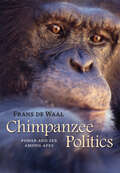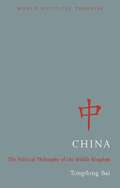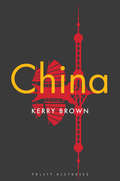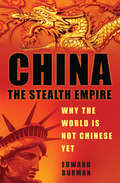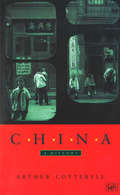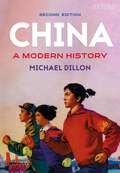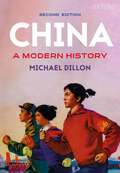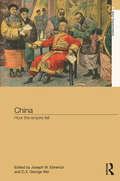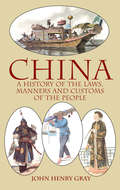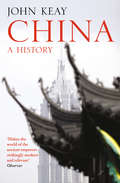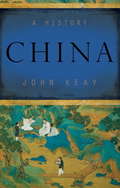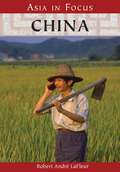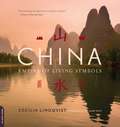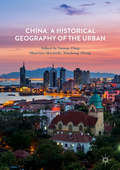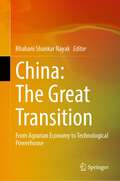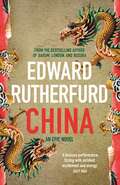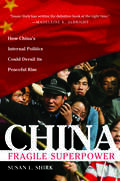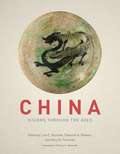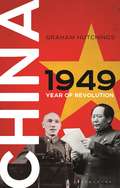- Table View
- List View
Chimpanzee Politics: Power and Sex among Apes
by Frans WaalThe first edition of Frans de Waal's Chimpanzee Politics was acclaimed not only by primatologists for its scientific achievement but also by politicians, business leaders, and social psychologists for its remarkable insights into the most basic human needs and behaviors. Still considered a classic, this updated edition is a detailed and thoroughly engrossing account of rivalries and coalitions—actions governed by intelligence rather than instinct. As we watch the chimpanzees of Arnhem behave in ways we recognize from Machiavelli (and from the nightly news), de Waal reminds us again that the roots of politics are older than humanity.
China: The Political Philosophy of the Middle Kingdom (World Political Theories)
by Tongdong BaiChina is a rising economic and political power. But what is the message of this rise? Tongdong Bai addresses this increasingly pressing question by examining the rich history of political theories and practices from China's past, and showing how it impacts upon the present.Chinese political traditions are often viewed negatively as 'authoritarian' (in contrast with 'Western' democratic traditions), but the historical reality is much more complex and there is a need to understand the political values shaping China's rise. Going beyond this, Bai argues that the debates between China's two main political theories - Confucianism and Legalism - anticipate themes in modern political thought and hence offer valuable resources for thinking about contemporary political problems.Part of Zed's World Political Theories series, this groundbreaking work offers a remarkable insight into the political history and thought of a nation that is becoming increasingly powerful on the world stage.
China: The Political Philosophy of the Middle Kingdom (World Political Theories)
by Tongdong BaiChina is a rising economic and political power. But what is the message of this rise? Tongdong Bai addresses this increasingly pressing question by examining the rich history of political theories and practices from China's past, and showing how it impacts upon the present.Chinese political traditions are often viewed negatively as 'authoritarian' (in contrast with 'Western' democratic traditions), but the historical reality is much more complex and there is a need to understand the political values shaping China's rise. Going beyond this, Bai argues that the debates between China's two main political theories - Confucianism and Legalism - anticipate themes in modern political thought and hence offer valuable resources for thinking about contemporary political problems.Part of Zed's World Political Theories series, this groundbreaking work offers a remarkable insight into the political history and thought of a nation that is becoming increasingly powerful on the world stage.
China: The Next Decade For The People's Republic Of China (Polity Histories)
by Kerry BrownChina is poised to become the world's largest economy in the next decade. But its great struggle to modernise has been one of tragedy, conflict, and challenge. From the first attempts to introduce Western ideas into the country two centuries ago, China's long march to global primacy has been above all an epic fight to renew an ancient country and culture. Leading Sinologist Kerry Brown traces this quest for renewal through the major moments of China’s modern history. Taking the reader on a journey that includes war, revolution, famine and finally regeneration, he describes concisely and authoritatively where China has come from, and where it is heading as it achieves great power status. This is a story that is no longer just about China, but concerns the rest of the world.
China: Why the World is Not Chinese Yet
by Edward BurmanWritten by a leading historian and China-based businessman, China: The Stealth Empire is the first book to combine a historical analysis withinsights into China?s current economic andpolitical development.
China: A History (Eyewitness Guides)
by Arthur CotterellOne of the most far-reaching events since the Second World War is the re-emergence of China as a world power, and its present government's willingness to open up the country to the rest of the world.This comprehensive cultural history ranges from prehistoric times to the present - from the disunity of Pre-Imperial China to the renaissance of the Sung and Tang dynasties, from the Mongol conquest to Tiananmen Square and the 1989 student revolt. By placing the modern country in historical perspective this brilliant study reveals how many continuities there are within the oldest of all civilizations.
China: A Modern History
by Michael DillonIn this complete guide to modern China, Michael Dillon takes students through its social, political and economic changes, from the Qing Empire, through the civil war and the Communist state, to its incarnation as a hybrid capitalist superpower. Key features of the new edition include: - A brand new chapter on the Xi Jinping premiership - Coverage of the recent developments in Hong Kong- Unique analysis of Tibet and Xinjiang- Teaching aides including biographies of leading figures, timelines and a glossary Clearly and compelling written, this textbook is essential for any student of the history or politics of modern China.
China: A Modern History (Durham East Asia Ser. #3)
by Michael DillonIn this complete guide to modern China, Michael Dillon takes students through its social, political and economic changes, from the Qing Empire, through the civil war and the Communist state, to its incarnation as a hybrid capitalist superpower. Key features of the new edition include: - A brand new chapter on the Xi Jinping premiership - Coverage of the recent developments in Hong Kong- Unique analysis of Tibet and Xinjiang- Teaching aides including biographies of leading figures, timelines and a glossary Clearly and compelling written, this textbook is essential for any student of the history or politics of modern China.
China: How the Empire Fell (Asia's Transformations)
by Joseph W. Esherick C.X. George WeiThe Qing dynasty was China’s last, and it created an empire of unprecedented size and prosperity. However in 1911 the empire collapsed within a few short months, and China embarked on a revolutionary course that lasted through most of the twentieth century. The 1911 Revolution ended two millennia of imperial rule and established the Republic of China, but dissatisfaction with the early republic fuelled further revolutionary movements, each intended to be more thoroughgoing than the last, from the National Revolution of the 1920s, to the Communist Revolution, and finally the Cultural Revolution. On the centenary of the 1911 Revolution, Chinese scholars debated the causes and significance of the empire’s collapse, and this book presents twelve of the most important contributions. Rather than focusing on Sun Yat-sen’s relatively weak and divided revolutionary movement, as much previous scholarship has, these studies examine the internal dynamics of political and socio-economic change in China. The chapters reveal how reforms in education, army organization, and constitutional rule created new social forces and political movements that undermined dynastic legitimacy within China and on its frontiers. Through detailed analyses, using new archival, memoir, diary, and newspaper sources, the authors cast new light on the sudden collapse of an empire that many thought was at last embarked on a road to reform and national rejuvenation. China: How the Empire Fell will be of huge interest to students and scholars of modern Chinese history as well as those of contemporary China.
China: How the Empire Fell (Asia's Transformations)
by Joseph W. Esherick C. X. George WeiThe Qing dynasty was China’s last, and it created an empire of unprecedented size and prosperity. However in 1911 the empire collapsed within a few short months, and China embarked on a revolutionary course that lasted through most of the twentieth century. The 1911 Revolution ended two millennia of imperial rule and established the Republic of China, but dissatisfaction with the early republic fuelled further revolutionary movements, each intended to be more thoroughgoing than the last, from the National Revolution of the 1920s, to the Communist Revolution, and finally the Cultural Revolution. On the centenary of the 1911 Revolution, Chinese scholars debated the causes and significance of the empire’s collapse, and this book presents twelve of the most important contributions. Rather than focusing on Sun Yat-sen’s relatively weak and divided revolutionary movement, as much previous scholarship has, these studies examine the internal dynamics of political and socio-economic change in China. The chapters reveal how reforms in education, army organization, and constitutional rule created new social forces and political movements that undermined dynastic legitimacy within China and on its frontiers. Through detailed analyses, using new archival, memoir, diary, and newspaper sources, the authors cast new light on the sudden collapse of an empire that many thought was at last embarked on a road to reform and national rejuvenation. China: How the Empire Fell will be of huge interest to students and scholars of modern Chinese history as well as those of contemporary China.
China: A History of the Laws, Manners and Customs of the People
by John Henry GrayThis highly readable history of the world's most populous country dates from the late nineteenth century, when its author, John Henry Gray, served as the Archdeacon of Hong Kong. His two-volume study, here bound into a single volume, begins with the earliest known legends of China as the "Middle Kingdom," around which all lesser states gathered like satellites, and ranges forward to an intriguing series of portraits of the author's Chinese contemporaries.Subjects include the functions and powers of government; prisons and forms of punishment; religion, gods, and goddesses, and Confucian philosophy; marriage and divorce; the roles of servants and slaves; festivals, amusements, and sports; funerals; astrology and fortune-telling; and benevolent institutions. Commercial activities — agricultural techniques, tea and silk production, and maritime pursuits — also receive detailed and informative treatments.Evocative illustrations include images of fireworks and flying kits, opium smokers and Buddhist nuns, traditional fishing techniques, and numerous other scenes from daily life. Of immense value to Sinologists and historians, this insightful volume will appeal to anyone interested in China and Far Eastern cultures.
China: A History
by John KeayThree thousand years of Chinese history in an accessible and authoritative single volume.
China: A History
by John KeayAn authoritative account of five thousand years of Chinese historyMany nations define themselves in terms of territory or people; China defines itself in terms of history. Taking into account the country's unrivaled, voluminous tradition of history writing, John Keay has composed a vital and illuminating overview of the nation's complex and vivid past. Keay's authoritative history examines 5,000 years in China, from the time of the Three Dynasties through Chairman Mao and the current economic transformation of the country. Crisp, judicious, and engaging, China is the classic single-volume history for anyone seeking to understand the present and future of this immensely powerful nation.
China (Nations in Focus)
by Robert André LaFleurAn up-to-date, concise examination of China—past and present—providing detailed information on a country whose substantial impact on the global economy and consumer culture continues to grow.Part of ABC-CLIO's Asia in Focus series, this authoritative resource is designed to help a wide variety of readers understand the complexities of the world's most populous country—a nation of ancient glory and rising importance, yet one that remains elusive and not generally well known.Packed with recent scholarship and fascinating details, this concise, multifaceted volume offers an updated look at China's geography and history, from the political and technological dominance of the imperial period to the communist revolution and the present state. The work also vividly captures the "living" China of today—its economy, politics, and culture—with extensive coverage of topics ranging from education, languages, arts, and cuisine to industrialization, gender issues, population control efforts, and human rights controversies that have impacted the country's relationship to the global community.
China: Empire of Living Symbols
by Cecilia LindqvistThe origins of Chinese ideographs were not known until 1899, when a scholar went to an apothecary for some medicine made of "dragon bone.” To his surprise, the bone, which had not yet been ground into powder, contained a number of carved inscriptions. Thus began the exploration of the 3000-year-old sources of the written characters still used in China today. In this unparalleled and deeply researched book, Cecilia Lindqvist tells the story of these characters and shows how their shapes and concepts have permeated all of Chinese thought, architecture, art, and culture.
China: A Historical Geography of the Urban
by Maurizio Marinelli Yannan Ding Xiaohong ZhangThis book offers a unique contribution to the burgeoning field of Chinese historical geography. Urban transformation in China constitutes both a domestic revolution and a world-historical event. Through the exploration of nine urban sites of momentous change, over an extended period of time, this book connects the past with the present, and provides much-needed literature on city growth and how they became complex laboratories of prosperity.The first part of this book puts Chinese urban changes into historical perspective, and probes the relationship between nation and city, focusing on Shanghai, Beijing and Changchun. Part two deals with the relationship between history and modernity, concentrating on Tunxi, a traditional trade center of tea, New Villages in Shanghai and street names in Taipei and Shanghai. Part three showcases the complexities of urban regeneration vis-à-vis heritage preservation in cities such as Datong, Tianjin and Qingdao. This book offers an innovative interdisciplinary and international perspective, which will be of interest to students and scholars of Chinese urban studies, as well Chinese politics and society.
China: From Agrarian Economy to Technological Powerhouse
by Bhabani Shankar NayakThis book explores the great transition of China from a subsistence agrarian economy to a technologically driven economic powerhouse which reflects the achievements of the hardworking Chinese people. China continues to grow as the second largest economy of the world from 2010 onwards. It is going to be the largest economy in the world by putting US economy behind. The Chinese GDP has increased of 1,500 times from 1952. This book examines the transformation of China and its economic growth is neither miraculous nor a product of market economy. Further, this book states economic development in China as a product of political pursuit shaped by the Chinese people led by the Communist Party of China from 1921 onwards. China is not only the workshop of the world today but also works as the engine of global economic growth and recovery of crisis ridden global economy. This book also shows how phenomenal Chinese economic growth and development led to the significant fall of poverty in China.This book states that the prosperous transition in China continues to show features of combined and uneven development. This is evident as China has largest billionaires, but many people still live and practice subsistence economy. However, many Chinese do not have access to clean air, water, sanitation and dignified sources of livelihoods. This book shows the social, economic and political inequalities as hindrances to deepening of democratic and egalitarian development in China. This book states that the gender gap and widening gap between urban and rural China are twin serious challenges to progressive transformations in China. The Chinese state and government are trying to implement different policies and programmes to overcome these challenges.
China: An Epic Novel
by Edward Rutherfurd'The unparallelled master of the historical saga returns, this time, with an eye on China. Beginning with the First Opium War in 1839 and continuing through the present day, Rutherfurd tells a sweeping tale that brings to life a nation's history, traditions and the people who lived through it as if by magic' Newsweek The internationally bestselling author portrays the great clash of East and West in his new epic: China China in the nineteenth century: a proud and ancient empire forbidden to foreigners. The West desires Chinese tea above all other things but lacks the silver to buy it. Instead, western adventurers resort to smuggling opium in exchange. The Qing Emperor will not allow his people to sink into addiction. Viceroy Lin is sent to the epicentre of the opium trade, Canton, to stop it. The Opium Wars begin - heralding a period of bloody military defeats, reparations, and one-sided treaties which will become known as the Century of Humiliation. From Hong Kong to Beijing to the Great Wall, from the exotic wonders of the Summer Palace and the Forbidden City, to squalid village huts, the dramatic struggle rages across the Celestial Kingdom. This is the story of the Chinese people, high and low, and the Westerners who came to exploit the riches of their ancient land and culture. We meet a young village wife struggling with the rigid traditions of her people, Manchu empresses and warriors, powerful eunuchs, fanatical Taiping and Boxer Rebels, savvy Chinese pirates, artists, concubines, scoundrels and heroes, well-intentioned missionaries and the rapacious merchants, diplomats and soldiers of the West. Fortunes will rise and fall, loves will be gained and lost.This is an unforgettable tale told from both sides of the divide. The clash of worldviews, of culture and heritage, is shown in a kaleidoscope of jaw-dropping set pieces. China is a feat of the imagination that will enthral, instruct and excite, and show us how things once were, and how the turmoil of the nineteenth century led to modern China's revolution and rebirth.
China: How China's Internal Politics Could Derail Its Peaceful Rise
by Susan L. ShirkOnce a sleeping giant, China today is the world's fastest growing economy--the leading manufacturer of cell phones, laptop computers, and digital cameras--a dramatic turn-around that alarms many Westerners. But in China: The Fragile Superpower, Susan L. Shirk opens up the black box of Chinese politics and finds that the real danger lies elsewhere--not in China's astonishing growth, but in the deep insecurity of its leaders. China's leaders face a troubling paradox: the more developed and prosperous the country becomes, the more insecure and threatened they feel. Shirk, a former Deputy Assistant Secretary of State responsible for China, knows many of today's Chinese rulers personally and has studied them for three decades. She offers invaluable insight into how they think--and what they fear. In this revealing book, readers see the world through the eyes of men like President Hu Jintao and former President Jiang Zemin. We discover a fragile communist regime desperate to survive in a society turned upside down by miraculous economic growth and a stunning new openness to the greater world. Indeed, ever since the 1989 pro-democracy protests in Tiananmen Square and the fall of communism in the Soviet Union, Chinese leaders have been haunted by the fear that their days in power are numbered. Theirs is a regime afraid of its own citizens, and this fear motivates many of their decisions when dealing with the U.S. and other foreign nations. In particular, the fervent nationalism of the Chinese people, combined with their passionate resentment of Japan and attachment to Taiwan, have made relations with these two regions a minefield. It is here, Shirk concludes, in the tangled interactions between Japan, Taiwan, China, and the United States, that the greatest danger lies. Shirk argues that rising powers such as China tend to provoke wars in large part because other countries mishandle them. Unless we understand China's brittle internal politics and the fears that motivate its leaders, we face the very real possibility of avoidable conflict with China. This book provides that understanding.
China: How China's Internal Politics Could Derail Its Peaceful Rise
by Susan L. ShirkOnce a sleeping giant, China today is the world's fastest growing economy--the leading manufacturer of cell phones, laptop computers, and digital cameras--a dramatic turn-around that alarms many Westerners. But in China: The Fragile Superpower, Susan L. Shirk opens up the black box of Chinese politics and finds that the real danger lies elsewhere--not in China's astonishing growth, but in the deep insecurity of its leaders. China's leaders face a troubling paradox: the more developed and prosperous the country becomes, the more insecure and threatened they feel. Shirk, a former Deputy Assistant Secretary of State responsible for China, knows many of today's Chinese rulers personally and has studied them for three decades. She offers invaluable insight into how they think--and what they fear. In this revealing book, readers see the world through the eyes of men like President Hu Jintao and former President Jiang Zemin. We discover a fragile communist regime desperate to survive in a society turned upside down by miraculous economic growth and a stunning new openness to the greater world. Indeed, ever since the 1989 pro-democracy protests in Tiananmen Square and the fall of communism in the Soviet Union, Chinese leaders have been haunted by the fear that their days in power are numbered. Theirs is a regime afraid of its own citizens, and this fear motivates many of their decisions when dealing with the U.S. and other foreign nations. In particular, the fervent nationalism of the Chinese people, combined with their passionate resentment of Japan and attachment to Taiwan, have made relations with these two regions a minefield. It is here, Shirk concludes, in the tangled interactions between Japan, Taiwan, China, and the United States, that the greatest danger lies. Shirk argues that rising powers such as China tend to provoke wars in large part because other countries mishandle them. Unless we understand China's brittle internal politics and the fears that motivate its leaders, we face the very real possibility of avoidable conflict with China. This book provides that understanding.
China: Visions through the Ages
by Thomas A. SkwerskiAt the entrance of The Field Museum’s Cyrus Tang Hall of China, two Chinese stone guardian lions stand tall, gazing down intently at approaching visitors. One lion’s paw rests upon a decorated ball symbolizing power, while the other lion cradles a cub. Traditionally believed to possess attributes of strength and protection, statues such as these once stood guard outside imperial buildings, temples, and wealthy homes in China. Now, centuries later, they guard this incredible permanent exhibition. China’s long history is one of the richest and most complex in the known world, and the Cyrus Tang Hall of China offers visitors a wonderful, comprehensive survey of it through some 350 artifacts on display, spanning from the Paleolithic period to present day. Now, with China: Visions through the Ages, anyone can experience the marvels of this exhibition through the book’s beautifully designed and detailed pages. Readers will gain deeper insight into The Field Museum’s important East Asian collections, the exhibition development process, and research on key aspects of China’s fascinating history. This companion book, edited by the exhibition’s own curatorial team, takes readers even deeper into the wonders of the Cyrus Tang Hall of China and enables them to study more closely the objects and themes featured in the show. Mirroring the exhibition’s layout of five galleries, the volume is divided into five sections. The first section focuses on the Paleolithic and Neolithic periods; the second, the Bronze Age, the first dynasties, and early writing; the third, the imperial system and power; the fourth, religion and performance; and the fifth, interregional trade and the Silk Routes. Each section also includes highlights containing brief stories on objects or themes in the hall, such as the famous Lanting Xu rubbing. With chapters from a diverse set of international authors providing greater context and historical background, China: Visions through the Ages is a richly illustrated volume that allows visitors, curious readers, and China scholars alike a chance to have an enduring exchange with the objects featured in the exhibition and with their multifaceted histories.
China: Visions through the Ages
by Thomas A. SkwerskiAt the entrance of The Field Museum’s Cyrus Tang Hall of China, two Chinese stone guardian lions stand tall, gazing down intently at approaching visitors. One lion’s paw rests upon a decorated ball symbolizing power, while the other lion cradles a cub. Traditionally believed to possess attributes of strength and protection, statues such as these once stood guard outside imperial buildings, temples, and wealthy homes in China. Now, centuries later, they guard this incredible permanent exhibition. China’s long history is one of the richest and most complex in the known world, and the Cyrus Tang Hall of China offers visitors a wonderful, comprehensive survey of it through some 350 artifacts on display, spanning from the Paleolithic period to present day. Now, with China: Visions through the Ages, anyone can experience the marvels of this exhibition through the book’s beautifully designed and detailed pages. Readers will gain deeper insight into The Field Museum’s important East Asian collections, the exhibition development process, and research on key aspects of China’s fascinating history. This companion book, edited by the exhibition’s own curatorial team, takes readers even deeper into the wonders of the Cyrus Tang Hall of China and enables them to study more closely the objects and themes featured in the show. Mirroring the exhibition’s layout of five galleries, the volume is divided into five sections. The first section focuses on the Paleolithic and Neolithic periods; the second, the Bronze Age, the first dynasties, and early writing; the third, the imperial system and power; the fourth, religion and performance; and the fifth, interregional trade and the Silk Routes. Each section also includes highlights containing brief stories on objects or themes in the hall, such as the famous Lanting Xu rubbing. With chapters from a diverse set of international authors providing greater context and historical background, China: Visions through the Ages is a richly illustrated volume that allows visitors, curious readers, and China scholars alike a chance to have an enduring exchange with the objects featured in the exhibition and with their multifaceted histories.
China: Visions through the Ages
by Thomas A. SkwerskiAt the entrance of The Field Museum’s Cyrus Tang Hall of China, two Chinese stone guardian lions stand tall, gazing down intently at approaching visitors. One lion’s paw rests upon a decorated ball symbolizing power, while the other lion cradles a cub. Traditionally believed to possess attributes of strength and protection, statues such as these once stood guard outside imperial buildings, temples, and wealthy homes in China. Now, centuries later, they guard this incredible permanent exhibition. China’s long history is one of the richest and most complex in the known world, and the Cyrus Tang Hall of China offers visitors a wonderful, comprehensive survey of it through some 350 artifacts on display, spanning from the Paleolithic period to present day. Now, with China: Visions through the Ages, anyone can experience the marvels of this exhibition through the book’s beautifully designed and detailed pages. Readers will gain deeper insight into The Field Museum’s important East Asian collections, the exhibition development process, and research on key aspects of China’s fascinating history. This companion book, edited by the exhibition’s own curatorial team, takes readers even deeper into the wonders of the Cyrus Tang Hall of China and enables them to study more closely the objects and themes featured in the show. Mirroring the exhibition’s layout of five galleries, the volume is divided into five sections. The first section focuses on the Paleolithic and Neolithic periods; the second, the Bronze Age, the first dynasties, and early writing; the third, the imperial system and power; the fourth, religion and performance; and the fifth, interregional trade and the Silk Routes. Each section also includes highlights containing brief stories on objects or themes in the hall, such as the famous Lanting Xu rubbing. With chapters from a diverse set of international authors providing greater context and historical background, China: Visions through the Ages is a richly illustrated volume that allows visitors, curious readers, and China scholars alike a chance to have an enduring exchange with the objects featured in the exhibition and with their multifaceted histories.
China: Visions through the Ages
by Thomas A. SkwerskiAt the entrance of The Field Museum’s Cyrus Tang Hall of China, two Chinese stone guardian lions stand tall, gazing down intently at approaching visitors. One lion’s paw rests upon a decorated ball symbolizing power, while the other lion cradles a cub. Traditionally believed to possess attributes of strength and protection, statues such as these once stood guard outside imperial buildings, temples, and wealthy homes in China. Now, centuries later, they guard this incredible permanent exhibition. China’s long history is one of the richest and most complex in the known world, and the Cyrus Tang Hall of China offers visitors a wonderful, comprehensive survey of it through some 350 artifacts on display, spanning from the Paleolithic period to present day. Now, with China: Visions through the Ages, anyone can experience the marvels of this exhibition through the book’s beautifully designed and detailed pages. Readers will gain deeper insight into The Field Museum’s important East Asian collections, the exhibition development process, and research on key aspects of China’s fascinating history. This companion book, edited by the exhibition’s own curatorial team, takes readers even deeper into the wonders of the Cyrus Tang Hall of China and enables them to study more closely the objects and themes featured in the show. Mirroring the exhibition’s layout of five galleries, the volume is divided into five sections. The first section focuses on the Paleolithic and Neolithic periods; the second, the Bronze Age, the first dynasties, and early writing; the third, the imperial system and power; the fourth, religion and performance; and the fifth, interregional trade and the Silk Routes. Each section also includes highlights containing brief stories on objects or themes in the hall, such as the famous Lanting Xu rubbing. With chapters from a diverse set of international authors providing greater context and historical background, China: Visions through the Ages is a richly illustrated volume that allows visitors, curious readers, and China scholars alike a chance to have an enduring exchange with the objects featured in the exhibition and with their multifaceted histories.
China 1949: Year of Revolution
by Graham HutchingsThe events of 1949 in China reverberated across the world and throughout the rest of the century. That tumultuous year saw the dramatic collapse of Chiang Kai-shek's 'pro-Western' Nationalist government, overthrown by Mao Zedong and his communist armies, and the foundation of the People's Republic of China.China 1949 follows the huge military forces that tramped across the country, the exile of once-powerful leaders and the alarm of the foreign powers watching on. The well-known figures of the Revolution are all here. But so are lesser known military and political leaders along with a host of 'ordinary' Chinese citizens and foreigners caught in the maelstrom. They include the often neglected but crucial role played by the 'Guangxi faction' within Chiang's own regime, the fate of a country woman who fled her village carrying her baby to avoid the fighting, a prominent Shanghai business man and a schoolboy from Nanyang, ordered by his teachers to trek south with his classmates in search of safety. Shadowing both the leaders and the people of China in 1949, Hutchings reveals the lived experiences, aftermath and consequences of this pivotal year -- one in which careers were made and ruined, and popular hopes for a 'new China' contrasted with fears that it would change the country forever. The legacy of 1949 still resonates today as the founding myth, source of national identity and root of the political behaviour of modern China. Graham Hutchings has written a vivid, gripping account of the year in which China abruptly changed course, and pulled the rest of world history along with it.
